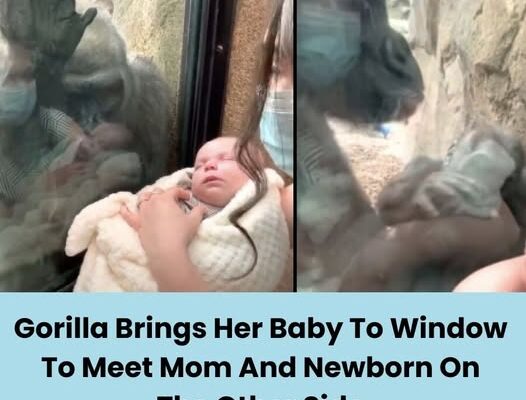A trip to the Franklin Park Zoo ended up being more than just a fun outing for Emmelina and Michael Austin. They took their one month old baby Canyon along and stopped at the gorilla enclosure where a mother gorilla named Kiki came right up to the glass.
Kiki leaned in close and kept her eyes on the baby. She touched the glass softly, just staring with that kind of look that another mom would understand, and it was clear she was fascinated. It felt like she already knew to be extra gentle.
Kiki was also a new mom herself and she had her 7 month old son Pablo. She seemed like she wanted to share him too. Michael explained: “My wife held up our son to show to Kiki, who was on the other side of the enclosure … then Kiki grabbed Pablo and put him on her leg to carry him over to us.”
For a few minutes the two mothers sat there together with their babies, one on each side of the glass. Emmelina said she could sense how much Kiki cared for Pablo now that she had become a mom herself, it felt like she understood it in a new way.
The Moment That Captured Hearts
The story begins with an ordinary family trip to the zoo. Parents and children walked along the exhibits, expecting to see lions basking in the sun, elephants strolling gracefully, and playful monkeys swinging from branch to branch. Among the many enclosures, the gorilla habitat stood out as a favorite. Gorillas, after all, are among the most fascinating primates, often seen as both fearsome due to their strength and endearing because of their uncanny resemblance to humans.
As the family approached the thick glass separating visitors from the gorilla habitat, they noticed one of the gorillas sitting calmly nearby. Instead of turning away or ignoring the crowd, the gorilla locked eyes with the family, particularly with one of the children. What followed was not a mere glance but an extended exchange of attention, curiosity, and almost recognition.
Witnesses described the atmosphere shifting around them. The noisy chatter of zoo visitors seemed to fade as the gorilla leaned closer, placing its hand on the glass in front of the family. The child, wide-eyed with awe, mimicked the gesture, placing their small palm against the same spot. For a brief moment, the thick glass wall that symbolized the barrier between species, between human and animal, seemed to disappear. There was only connection—two beings from different worlds recognizing each other in silence.
Why This Moment Resonates So Deeply
Why do moments like these strike such a chord with us? Part of the answer lies in the fact that gorillas are not only physically impressive but also highly emotional and intelligent creatures. They are capable of expressions, empathy, and complex social interactions that mirror our own.
When people witness a gorilla looking into the eyes of a human with what appears to be understanding, it triggers something innate. We are reminded that despite our differences, there is a shared essence—life, emotion, family, survival. The gesture of placing a hand on the glass is symbolic of longing for connection beyond barriers. It tells us that animals are not merely background actors in our world; they are sentient beings capable of relationships, bonds, and feelings.
For the family who experienced this encounter firsthand, it was more than a trip to the zoo. It was an intimate, unforgettable exchange that reinforced the beauty of empathy and recognition between species. For those who later saw or heard about it, the story became a source of inspiration, stirring conversations about compassion, conservation, and coexistence.
Gorillas: The Gentle Giants of the Animal Kingdom
To understand the weight of such an encounter, we must take a closer look at gorillas themselves. Often misunderstood because of their size and strength, gorillas are actually gentle giants.
They live in tight-knit family groups called troops, led by a dominant silverback male who protects and guides them. Gorillas are vegetarians, spending their days foraging for leaves, fruits, and stems. They are not aggressive unless provoked or threatened, and even then, their intimidating chest-beating and roars are often more about warning than actual intent to harm.
But what truly makes gorillas extraordinary is their intelligence. They have been observed using tools, solving problems, and even learning sign language in captivity. Famous gorillas like Koko, who communicated with humans through hundreds of signs, demonstrated the species’ deep capacity for thought and emotion. Gorillas mourn their dead, comfort one another, and form lifelong bonds.
So when a gorilla sits quietly with a family at a zoo, gazing intently and engaging in gestures of empathy, it is not random—it is a window into their complex emotional world.
The Role of Family in the Encounter
Another reason this emotional zoo moment strikes a universal chord is because it revolves around family. Gorillas are family-oriented animals, and humans are the same. The family unit—whether gorilla troop or human household—represents safety, love, and belonging.
When the gorilla leaned toward the human family, some interpreted it as recognition of shared values. Just as gorillas protect and nurture their young, human parents do the same. Just as gorillas rely on the strength of their group, humans rely on family bonds to navigate life.
In this way, the encounter became a mirror. The family standing on one side of the glass, united in awe and love for one another, was reflected in the gorilla, who embodies similar instincts. It was a powerful reminder that despite species differences, the core of existence—family, connection, care—is universal.
Beyond the Glass: Barriers That Separate Us
While the moment is beautiful, it also carries an undercurrent of sadness. The glass that separated the gorilla and the family is symbolic of the barriers that exist between humans and the natural world. On one hand, zoos provide opportunities for education and conservation awareness, giving people the chance to see animals they might never encounter in the wild. On the other, they also remind us of the captivity and loss of freedom animals experience.
The emotional resonance of the gorilla pressing its hand against the glass makes us reflect on these barriers. What would it be like if gorillas did not have to live behind walls? What kind of world could we create if humans prioritized protecting natural habitats instead of destroying them? The story, therefore, is not just about a family’s magical zoo experience—it is also about the larger narrative of coexistence, responsibility, and the role we play in shaping the fate of wildlife.



